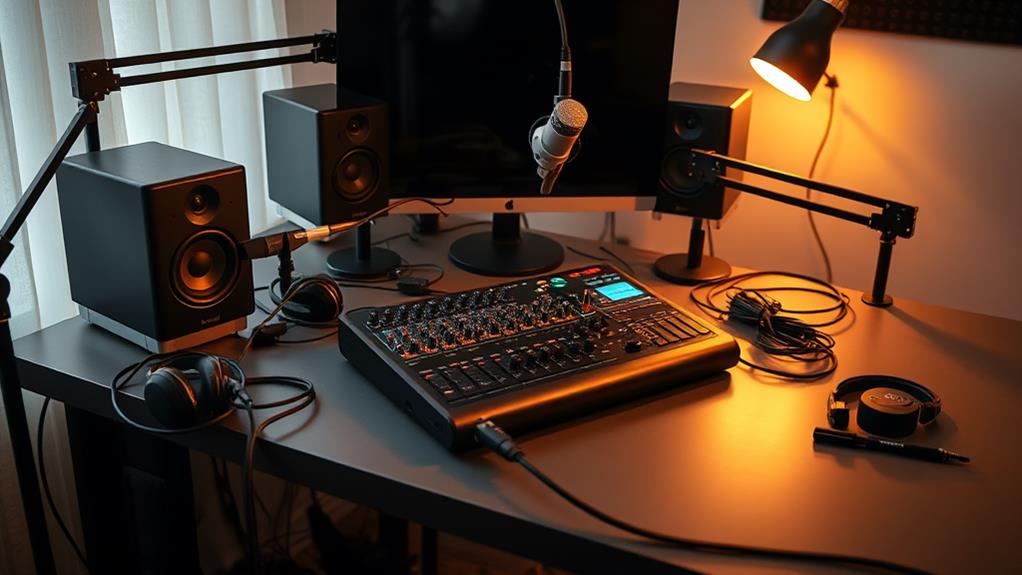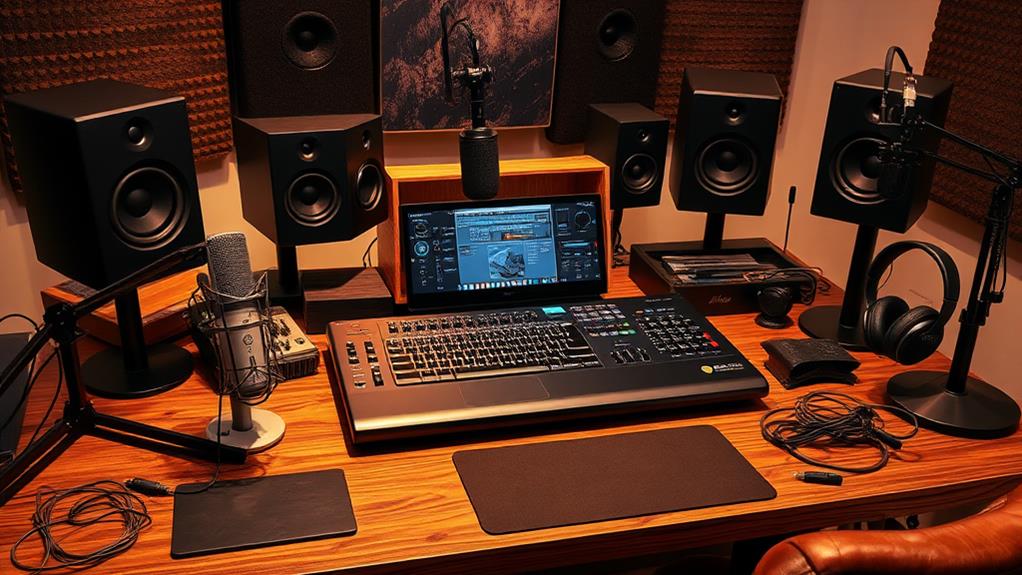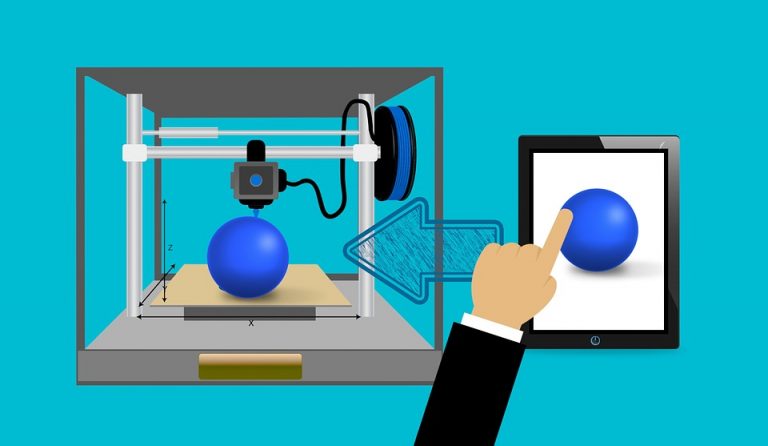When selecting an audio interface for pristine sound quality today, you’ll find options like the Behringer U-Phoria UMC22, PreSonus Quantum ES 2, and Native Instruments Komplete Audio 1 leading the pack.
These devices offer high-resolution recording capabilities, low-latency performance, and user-friendly designs. Key features to contemplate include input/output configurations, preamp quality, sample rate capabilities, and software compatibility. Many interfaces, such as the Focusrite Scarlett Solo 3rd Gen, provide professional-grade mic preamps and bundled software suites.
While compact models like the PreSonus AudioBox GO suit mobile setups, larger units offer more versatility for studio environments. Understanding the pros and cons of each interface will help you make an informed decision.
Main Points
- Audio interfaces with high sample rates (up to 192 kHz) and 24-bit depth offer superior sound quality and dynamic range.
- Preamp quality significantly impacts recording clarity, with low noise floors and high gain capabilities being essential.
- Low-latency performance (around 5ms or lower) is crucial for real-time monitoring and professional recording.
- Compatibility with popular DAWs and included software bundles enhances the interface’s versatility and value.
- Durable construction, multiple I/O options, and portability features cater to different recording needs and environments.
Behringer U-Phoria UMC22 USB Audio Interface
Behringer U-Phoria UMC22 USB Audio Interface
Compact 2×2 USB audio interface with 48 kHz sampling rate. Features a Midas-designed mic preamp, XLR/TRS combo input, 1/4″ instrument input, headphone output, and 2 outputs. USB-powered for portability. Ideal for recording vocals and instruments, and creating professional-quality audio.
For budget-conscious musicians and podcasters looking to dip their toes into home recording, the Behringer U-Phoria UMC22 USB Audio Interface stands out as a top contender in 2024. This compact, 2-channel device offers a MIDAS-designed mic preamp and versatile inputs for both microphones and instruments. With its all-metal casing and weighty knobs, the UMC22 boasts durability that exceeds expectations for its price point.
While it supports a maximum recording quality of 48kHz, which is suitable for most budget users, the UMC22 does have some limitations. The monitor output quality has been noted as poor, with an audible hiss on the headphone jack. However, the clean sound output and direct monitoring feature make it a viable option for home recording and light podcasting. At around $40, it’s a cost-effective choice that competes with more expensive brands, earning it high marks for value among users.
Best For: Budget-conscious musicians, podcasters, and home recording enthusiasts seeking an affordable, durable USB audio interface with basic functionality.
Pros:
- Cost-effective solution with performance comparable to more expensive brands
- Durable all-metal construction with high-quality MIDAS-designed mic preamp
- Versatile inputs for both microphones and instruments without needing a DI box
Cons:
- Limited to 48kHz maximum recording quality
- Poor monitor output quality with audible hiss on the headphone jack
- Signal/clipping lights only functional at higher gain levels
PreSonus Quantum ES 2 USB-C Audio Interface
PreSonus Quantum ES 2 USB-C Audio Interface
Quantum ES 2 audio interface: 2 MAX-HD preamps with +75 dB gain, instrument input, Auto Gain feature, illuminated encoder, LED metering. Ideal for musicians and creators. Offers high-quality preamps, low-noise converters, and smooth DAW integration for pristine audio capture.
Home studio enthusiasts seeking professional-grade audio quality will find the PreSonus Quantum ES 2 USB-C Audio Interface an impressive solution. This 2×2 interface offers 24-bit/192 kHz resolution and features MAX-HD mic preamps with +75 dB gain, delivering transparent and low-noise performance. The device’s high-performance converters and low-latency driver guarantee exceptional sound quality, while the Auto Gain button simplifies recording setup.
You’ll appreciate the interface’s solid build quality and compact design, making it suitable for limited-space setups. The included 6-month Studio One+ membership provides access to professional recording software. However, be aware that the Quantum ES 2 lacks hardware monitoring, requiring DAW routing for input monitoring. Despite this limitation, users report satisfaction with the interface’s audio quality and ease of use, noting significant improvements over older models like the Focusrite Saffire Pro 40.
Best For: Home studio owners and music producers seeking professional-grade audio quality with low latency in a compact, USB-C interface.
Pros:
- Exceptional sound quality with high-performance converters and low-latency driver
- MAX-HD mic preamps offer transparent, low-noise performance with +75 dB gain
- Includes a 6-month Studio One+ membership for professional recording software
Cons:
- Lacks hardware monitoring, requiring DAW routing for input monitoring
- Some users report difficulties with customer support for software activation
- The power supply connection could be improved for better stability
Native Instruments Komplete Audio 1 Two-Channel Audio Interface
Native Instruments Komplete Audio 1 Two-Channel Audio Interface
Versatile audio interface for recording vocals and instruments simultaneously. Features XLR input for mics, jack input for guitars/line-in sources, and stereo RCA outputs for hi-fi speaker connectivity. Ideal for capturing mono sounds and playing them back through external speakers.
Musicians and podcasters seeking a user-friendly, high-quality audio interface will find the Native Instruments Komplete Audio 1 an excellent choice. This two-channel interface offers versatile input options, including an XLR input for vocals and a jack input for guitars or line-in sounds. Its stereo RCA outputs connect directly to hi-fi speakers, ensuring seamless integration with your existing audio setup.
Users praise the Komplete Audio 1 for its easy installation process on Windows 10 and its compatibility with various digital audio workstations (DAWs). The interface’s modern design and clean sound quality make it a standout option for recording instruments and vocals. While some users report issues with the monitoring fader and weak mic signals, these can often be addressed through EQ adjustments. Overall, the Native Instruments Komplete Audio 1 provides excellent value for money, combining functionality and aesthetic appeal in a compact package.
Best For: Musicians, podcasters, and content creators looking for an affordable, user-friendly audio interface with high-quality sound and versatile input options.
Pros:
- Easy setup and compatibility with various DAWs
- Clean sound quality for recording instruments and vocals
- Compact and aesthetically pleasing design
Cons:
- Monitoring fader issues limiting simultaneous audio levels
- Weak mic signals reported by some users
- Limited to two input channels, which may not be sufficient for more complex recording setups
PreSonus AudioBox GO USB-C Audio Interface
Acer Chromebook Spin 311 Convertible Laptop (CP311-2H-C679)
Compact, powerful audio interface for home and mobile recording. Features XLR and instrument inputs, headphone/monitor outputs. Bus-powered, plug-and-play USB connectivity. Includes Studio One Prime DAW and Studio Magic software bundle. Ideal for beginners and space-conscious studios.
Aspiring podcasters and budget-conscious musicians will find the PreSonus AudioBox GO USB-C Audio Interface an ideal entry point into high-quality recording. This compact, ultra-portable device offers 24-bit/96 kHz audio with studio-grade converters, ensuring professional sound quality. You’ll find one XLR mic/line combo input for vocals or instruments, and a separate TS input for guitar or bass. The interface’s bus-powered design, compatible with Apple and Android devices, makes it perfect for on-the-go recording.
While the AudioBox GO shines in its portability and clear preamp sound, it’s not without limitations. The maximum gain of 50 dB may be insufficient for dynamic microphones without an additional preamp. Some users have reported difficulties with software installation and firmware updates. Despite these challenges, the included Studio One Prime DAW and Studio Magic bundle provide excellent value for beginners looking to start their recording journey.
Best For: Beginner podcasters, musicians on a budget, and mobile recording enthusiasts seeking a compact, high-quality audio interface for basic recording needs.
Pros:
- Ultra-portable design ideal for on-the-go recording
- Professional 24-bit/96 kHz audio quality with studio-grade converters
- Includes a valuable software bundle with Studio One Prime DAW and Studio Magic
Cons:
- A limited 50 dB gain may be insufficient for dynamic microphones
- Some users report difficulties with software installation and firmware updates
- Not suitable for complex recording setups or professional studio environments
Behringer U-Phoria UMC404HD USB Audio Interface
Behringer U-Phoria UMC404HD USB Audio Interface
Versatile USB 2.0 audio interface with 4 Midas-designed mic preamps, phantom power, and 24-Bit/192 kHz converters. Ideal for recording vocals, instruments, and MIDI devices. Suitable for studio production, live performances, and mobile setups. Offers professional-grade sound quality and connectivity.
…
For those seeking a budget-friendly yet powerful audio interface, the Behringer U-Phoria UMC404HD stands out as a top contender in 2024. This 4-in/4-out USB 2.0 interface boasts impressive features, including four MIDAS preamps, 24-bit/192kHz audio quality, and versatile input options.
You’ll appreciate its pristine sound quality for vocals, instruments, and podcasts, with individual gain controls and pad switches for precise level adjustments. The UMC404HD offers seamless USB connectivity and works well with major Digital Audio Workstations (DAWs). It’s particularly suitable for home studios and live recording venues, catering to both beginners and experienced musicians.
While some users report concerns about build quality and occasional driver issues, the overall value and performance of this interface make it a popular choice to achieve professional-grade recordings without breaking the bank.
Best For: Aspiring musicians, podcasters, and home studio enthusiasts seeking a feature-rich, budget-friendly audio interface with professional-grade sound quality.
Pros:
- High-quality MIDAS preamps deliver pristine sound for various audio sources
- Versatile input options and seamless compatibility with major DAWs
- Excellent value for money, offering professional features at an affordable price
Cons:
- Some users report concerns about the long-term durability of knobs and overall build quality
- Occasional driver issues may require troubleshooting during initial setup
- Limited to four channels, which may not be sufficient for more complex recording setups
Behringer U-Phoria UMC202HD USB Audio Interface
Behringer U-Phoria UMC202HD USB Audio Interface
Compact USB 2.0 audio interface with 2 Midas-designed mic preamps, +48V phantom power, and 24-bit/192 kHz converters. Ideal for recording vocals, guitars, bass, and keyboards directly to your computer. Perfect for singer-songwriters, producers, and live performers needing reliable audio input.
Budget-conscious creators seeking professional-grade audio capture will find the Behringer U-Phoria UMC202HD USB Audio Interface a compelling option. This compact device, measuring 9.92 x 6.22 x 3.46 inches and weighing just 1.19 pounds, packs a punch with its metal chassis and impact-resistant design.
You’ll benefit from two Midas-designed mic preamps with +48 Volt phantom power, perfect for condenser microphones. The interface boasts studio-grade 24-bit/192 kHz converters, ensuring high-quality audio recordings.
Compatibility isn’t an issue, as the UMC202HD works seamlessly with popular software like Avid Pro Tools and Ableton Live. Users praise its sound quality, build, and ease of use, with many reporting no latency issues.
The overall performance, including its frequency response of 20 Hz to 20 kHz (+/- 0.17 dB) and low noise levels (-93.7 dBA), makes this interface an excellent choice for beginners and budget-conscious professionals alike.
Best For: Aspiring musicians, podcasters, and home studio enthusiasts looking for a high-quality, budget-friendly USB audio interface with professional-grade features.
Pros:
- High-quality Midas-designed preamps with phantom power for excellent audio capture
- Impressive 24-bit/192 kHz converters for studio-grade sound quality
- Robust metal chassis and compact design for durability and portability
Cons:
- Some units have been reported to arrive with minor scratches
- Lack of a mono button for easier monitoring
- The pad switch only attenuates input, potentially affecting noise performance
Behringer U-Phoria UM2 USB Audio Interface
Behringer U-Phoria UM2 USB Audio Interface
Compact 2×2 USB audio interface with 48 kHz sampling rate. Features XENYX mic preamp, XLR/TRS combo input, 1/4″ instrument input, and headphone output. Offers direct monitoring and USB power. Ideal for portable recording with professional-quality sound capture.
Musicians and podcasters seeking an affordable entry into digital recording will find the Behringer U-Phoria UM2 USB Audio Interface a compelling option. This compact 2×2 USB interface features a XENYX preamp, 48 kHz sampling rate, and versatile input options. You’ll find a combination XLR/TRS input for vocals or line-level sources, plus a dedicated 1/4″ instrument input that eliminates the need for a separate DI box.
The UM2 boasts clear sound quality with minimal noise at lower gain settings. It’s compatible with various DAWs and operating systems, making it suitable for different recording setups.
While it has limitations, such as all-or-nothing phantom power across inputs, the interface provides good value for its price point. You’ll appreciate its portability and straightforward operation, though be aware that some users have reported software compatibility issues. Overall, the UM2 serves as a solid starting point for home recording projects.
Best For: Musicians, podcasters, and content creators seeking an affordable, compact USB audio interface for basic home recording and streaming setups.
Pros:
- Affordable price point with good value for features
- Compact and portable design with USB power
- Versatile input options, including XLR/TRS combo and dedicated instrument input
Cons:
- Limited to 48 kHz sampling rate
- All-or-nothing phantom power across inputs
- Some users report software compatibility issues
M-Audio M-Track Duo USB Audio Interface for Recording and Streaming
M-Audio M-Track Duo USB Audio Interface for Recording and Streaming
Compact USB audio interface with 2 combo inputs, 48 kHz resolution. Features Crystal Preamps, phantom power, and zero-latency monitoring. Ideal for recording music, podcasts, and streaming on Mac/PC. Includes MPC Beats software for immediate use.
Compact and versatile, the M-Audio M-Track Duo USB Audio Interface is a go-to choice for aspiring producers and content creators. This USB-powered device offers 48 kHz audio resolution, ensuring high-quality recordings for your projects. With two combo XLR/Line/Instrument inputs and phantom power, you can connect various microphones and instruments.
The interface features zero-latency monitoring through main outputs and a headphone jack, allowing you to hear your recordings in real-time. You’ll appreciate the USB/Direct switch, which lets you balance input and playback levels.
The M-Track Duo comes bundled with MPC Beats software and is compatible with popular Digital Audio Workstations (DAWs) for both Mac and PC.
Users praise its sound quality and ease of use, making it an excellent option for beginners or as a backup interface. While it’s constructed with lower-quality materials, it delivers impressive sound performance for its price point.
Best For: Beginners, content creators, and musicians seeking an affordable, portable USB audio interface for recording, streaming, and podcasting.
Pros:
- High-quality 48 kHz audio resolution for professional-sounding recordings
- Versatile inputs with phantom power support a variety of microphones and instruments
- Includes a useful software bundle and is compatible with popular DAWs
Cons:
- Constructed with lower-quality materials, which may affect durability
- Some users report issues with input channel pots and occasional power loss
- Limited to two inputs, which may not be sufficient for more complex recording setups
PreSonus Studio 24c USB Audio Interface with Recording Software
PreSonus Studio 24c USB Audio Interface with Recording Software
Compact USB-C audio interface with 2 XMAX-L preamps and high-quality inputs for recording. Includes Studio One Artist software and Studio Magic plugins. Ideal for podcasts, music production, and home studios. Professional features in a portable, bus-powered design.
The PreSonus Studio 24c‘s versatility shines for home recording enthusiasts and mobile producers. This compact, bus-powered interface offers 2×2 channels and high-resolution 192 kHz recording capability.
You’ll find two XMAX-L solid-state mic preamps and two instrument/line inputs, perfect for recording vocals and instruments simultaneously. The device supports 24-bit, 192 kHz audio with low-latency monitoring, guaranteeing professional-grade sound quality.
You’ll appreciate the included software bundle, featuring Studio One Artist and Ableton Live Lite DAWs, plus the Studio Magic Plug-In Suite. The interface’s USB-C connectivity guarantees compatibility with modern devices, while its sturdy build and professional metering make it reliable for various recording scenarios.
Though some users note limitations with gain for certain microphones, the Studio 24c’s overall performance and ease of use have earned it a strong 4.6-star rating from over 3,000 customers.
Best For: Home recording enthusiasts, podcasters, and mobile producers seeking a compact, high-quality audio interface with bundled software for immediate recording capabilities.
Pros:
- High-resolution 192 kHz recording with low-latency monitoring
- Includes valuable software bundle (Studio One Artist, Ableton Live Lite, Studio Magic Plug-In Suite)
- Versatile inputs for microphones and instruments with professional metering
Cons:
- May require additional equipment (e.g., Cloudlifter) for certain microphones due to gain limitations
- Limited to 2×2 channels, which may not suffice for more complex recording setups
- Some users may find the learning curve steep for the included software
Focusrite Scarlett Solo 3rd Gen USB Audio Interface
Focusrite Scarlett Solo 3rd Gen USB Audio Interface
Compact USB audio interface for singer-songwriters. Features high-quality converters, mic preamp with Air mode, instrument input, and balanced outputs. Includes Hitmaker Expansion software bundle with plugins and DAWs. Portable design, no external power needed.
Designed for guitarists, vocalists, podcasters, and producers seeking studio-quality recording, the Focusrite Scarlett Solo 3rd Gen USB Audio Interface stands out as a top choice in 2024.
This compact device offers high-performance mic pre-amps with a switchable Air mode for enhanced clarity in acoustic recordings. You’ll find two high-headroom instrument inputs for guitars and basses, featuring Gain Halos for easy level setting. The interface boasts 24-bit/192kHz AD-DA converters, ensuring professional sound quality.
You can connect the Scarlett Solo directly to your Mac or PC via USB, eliminating the need for an external power source. It comes with a suite of software tools, including Ableton Live Lite and a three-month subscription to Avid Pro Tools Artist.
Users praise its simplicity and sound quality, though some note limitations in input options. With a 4.7-star rating from over 26,000 reviews, it’s clear why this interface ranks highly in its category.
Best For: Musicians, podcasters, and content creators seeking a compact, high-quality USB audio interface for recording vocals and instruments with professional-grade sound.
Pros:
- High-performance mic preamps with switchable Air mode for enhanced clarity
- Easy setup and user-friendly design, ideal for beginners and professionals alike
- Comprehensive software bundle including Ableton Live Lite and Pro Tools Artist subscription
Cons:
- Limited input options compared to larger interfaces
- The lack of MIDI ports may be a drawback for some users
- The USB-powered design might not be suitable for all mobile recording scenarios
Factors to Consider When Choosing an Audio Interface

When you’re in the market for an audio interface, several key factors should be carefully considered. Your choice should be guided by considerations such as input/output configuration, preamp quality, sample rate capabilities, latency performance, and software compatibility. Each of these elements plays a role in determining how well the interface will meet your specific audio recording and production needs.
Input/Output Configuration
As you explore the world of audio interfaces, understanding input/output configurations becomes essential for matching your recording needs. The I/O setup of an interface determines the number of devices that can be simultaneously connected, with options typically ranging from 2×2 to 4×4 configurations. This means you’ll be able to record multiple microphones or instruments at once, depending on your chosen interface.
You’ll find various input types on most interfaces, including XLR for microphones and 1/4″ jacks for instruments, giving you flexibility in connecting different audio sources. For outputs, you’ll encounter balanced TRS or unbalanced RCA connections, which affect compatibility with your studio monitors or other playback devices. Some interfaces also offer MIDI I/O, allowing you to connect MIDI controllers or synthesizers, expanding your creative possibilities.
Don’t overlook the importance of dedicated headphone outputs with direct monitoring. This feature lets you listen to inputs with zero latency, enhancing your recording experience. When choosing an interface, consider your current and future needs to guarantee you select a device that can grow with your studio setup.
Preamp Quality
Preamp quality stands out as one of the most critical factors in choosing an audio interface. The preamps in your interface greatly impact the clarity and noise level of your recordings. Better preamps provide cleaner sound with lower distortion rates, ensuring your audio maintains its integrity. When evaluating preamp quality, look for features like phantom power for condenser microphones and adjustable gain settings to accommodate various input sources.
Pay close attention to the preamp’s noise floor, as this affects the amount of unwanted background noise in your recordings. A low-noise floor minimizes hiss and other audio artifacts.
Additionally, consider the gain range of the preamps. A higher maximum gain, such as +75 dB, allows for better performance with dynamic microphones and quieter sound sources. Some high-end interfaces feature digitally controlled preamps or designs co-developed with reputable audio brands, often leading to more consistent sound quality and an enhanced user experience.
By prioritizing preamp quality in your audio interface selection, you’re investing in clearer, more professional-sounding recordings from the start.
Sample Rate Capabilities
An audio interface’s sample rate capabilities play an essential role in determining the quality and fidelity of your recordings. Sample rate refers to the number of audio samples captured per second, with higher rates allowing for more detailed sound reproduction. Common sample rates include 44.1 kHz, 48 kHz, and up to 192 kHz for professional applications.
For most users, a sample rate of 44.1 kHz is sufficient, as it’s the standard for CD-quality audio. If you’re working in video production or broadcasting, you’ll want to opt for an interface that supports 48 kHz. Higher sample rates, such as 192 kHz, offer greater frequency response and dynamic range but require more processing power and storage space.
When choosing an audio interface, consider your specific needs. If you’re recording music or podcasts, 44.1 kHz or 48 kHz will likely meet your requirements. However, if you’re involved in professional audio production, you might benefit from higher sample rates.
Remember that bit depth also affects audio quality, with 24-bit recording providing a theoretical dynamic range of 144 dB, considerably surpassing the 16-bit limit of CD audio.
Latency Performance
Latency performance is a factor to consider when choosing an audio interface. It refers to the delay between your input signal being processed and the output sound being heard, which can greatly impact your recording and monitoring experience. For ideal real-time monitoring during recording sessions, look for interfaces that offer latency values around 5ms or lower.
When evaluating an audio interface’s latency performance, consider its driver design. Interfaces with low-latency drivers allow faster processing and reduced delay. You’ll also want to pay attention to buffer size settings in your digital audio workstation (DAW), as smaller buffer sizes generally reduce latency. However, very small buffer sizes may increase the risk of audio dropouts.
Many users prioritize interfaces with zero-latency monitoring features, which allow you to hear your input signal in real-time without any delay. This can be particularly useful for vocalists and instrumentalists who need to monitor their performance while recording.
When comparing audio interfaces, look for specifications related to latency and consider how they align with your specific recording needs and workflow preferences.
Software Compatibility
Software compatibility is an important factor to take into account when selecting an audio interface. When choosing your device, make sure it’s compatible with your preferred Digital Audio Workstation (DAW).
Many interfaces support popular DAWs like Pro Tools, Ableton Live, and FL Studio, so you’ll want to verify that your chosen interface works seamlessly with your software. Additionally, check if the interface comes bundled with any software or plugins, as these can enhance your recording and production capabilities without extra costs.
Look for interfaces that offer easy driver installation and plug-and-play functionality to simplify the setup process on your operating system. This can save you time and frustration when getting started.
It’s vital to verify that the interface’s software supports low-latency monitoring, which allows for real-time audio feedback during recording sessions. This feature is important for maintaining timing and accuracy while tracking.
Finally, consider whether the interface includes features like MIDI I/O (input/output) or loopback functionality. These additional capabilities may be significant depending on your specific recording and production needs, so assess your requirements carefully before making a decision.
Portability and Build
When it comes to audio interfaces, portability and build quality are essential factors to take into consideration. If you’re a mobile recordist, you’ll want to prioritize lightweight and compact models that can easily fit into small bags or even pockets. These portable interfaces are ideal for on-the-go recording sessions and travel.
Build quality is another vital aspect to reflect on. Interfaces with all-metal casings typically offer superior durability and resistance to wear and tear compared to their plastic counterparts. While heavier interfaces may provide a sense of stability, lighter models can enhance portability for those who frequently move their setup.
The design and layout of knobs and inputs should be user-friendly, allowing for easy access and operation, especially in cramped spaces or during live performances. You’ll also want to look for interfaces with secure connections, such as twist-to-lock power plugs, to prevent accidental disconnections during use.
When evaluating portability and build, reflect on your specific needs. If you’re primarily studio-based, a heavier, more robust interface might be suitable. However, if you’re often recording in various locations, a lightweight, compact model with durable construction would be more appropriate.
Frequently Asked Questions
How Often Should I Calibrate My Audio Interface?
You should calibrate your audio interface regularly to maintain peak performance. Typically, calibration is recommended every few months, but this can vary based on usage and environmental factors. If you’re a professional or frequent user, monthly calibration might be beneficial. However, if you notice any issues with sound quality or levels, it’s wise to calibrate immediately. Many modern interfaces have built-in calibration tools, making the process easier. Always consult your device’s manual for specific calibration instructions and frequency recommendations.
Can I Use Multiple Audio Interfaces Simultaneously on One Computer?
You can use multiple audio interfaces simultaneously on one computer, but it requires some setup. Most operating systems allow for aggregate devices, which combine multiple interfaces into a single virtual device. This can be useful for expanding your input/output capabilities or creating complex routing setups. However, you’ll need to guarantee your computer has enough processing power and appropriate drivers. It’s also important to take into account potential latency issues and synchronization challenges when working with multiple interfaces concurrently.
Are There Any Compatibility Issues Between Audio Interfaces and DAW Software?
You may encounter compatibility issues between audio interfaces and DAW software, though they’re generally rare. Most modern interfaces use standard drivers, like ASIO for Windows or Core Audio for Mac, which work with most DAWs. However, some interfaces have proprietary software or specific features that may not be fully supported by all DAWs. It’s important to check the manufacturer’s specifications and your DAW’s requirements before purchasing. Additionally, guarantee you’re using the latest drivers and software versions to minimize potential conflicts.
What’s the Difference Between Balanced and Unbalanced Inputs on Audio Interfaces?
You’ll find that balanced inputs on audio interfaces use three-conductor cables, which help reject electromagnetic interference and noise. They’re ideal for longer cable runs. In contrast, unbalanced inputs use two-conductor cables, which are more susceptible to noise pickup. While unbalanced connections are simpler and often found on consumer gear, balanced connections are preferred in professional settings. You’ll typically see balanced inputs on XLR and TRS connectors, while unbalanced inputs are common on RCA and TS connectors.
How Do Audio Interfaces Affect Latency in Music Production?
Audio interfaces greatly impact latency in music production. They convert analog signals to digital and vice versa, affecting the time it takes for sound to travel through your system. You’ll experience lower latency with interfaces that have efficient drivers and high-speed connections like Thunderbolt or USB 3.0. The interface’s buffer size, which you can adjust in your recording software, also plays an essential role. A smaller buffer reduces latency but increases CPU load, while a larger buffer does the opposite.














